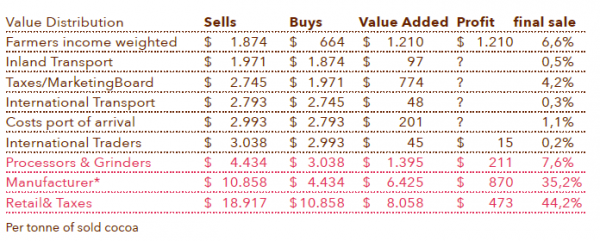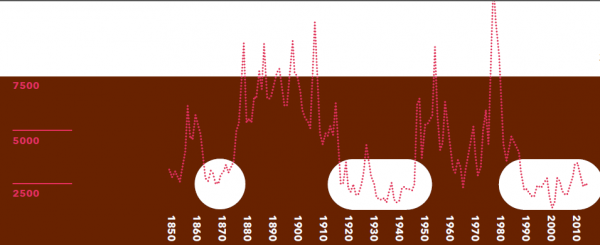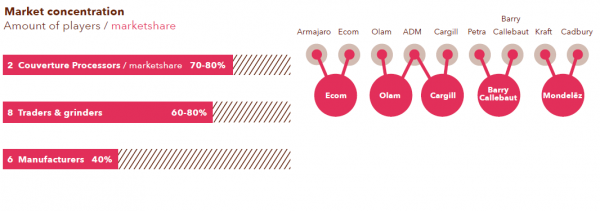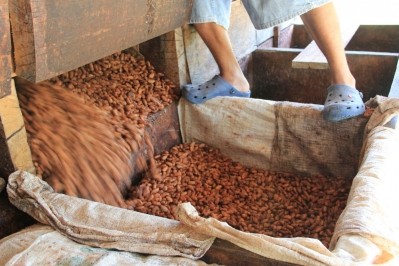Cocoa Barometer 2015
Extreme poverty ignored in sustainable cocoa drive, say NGOs
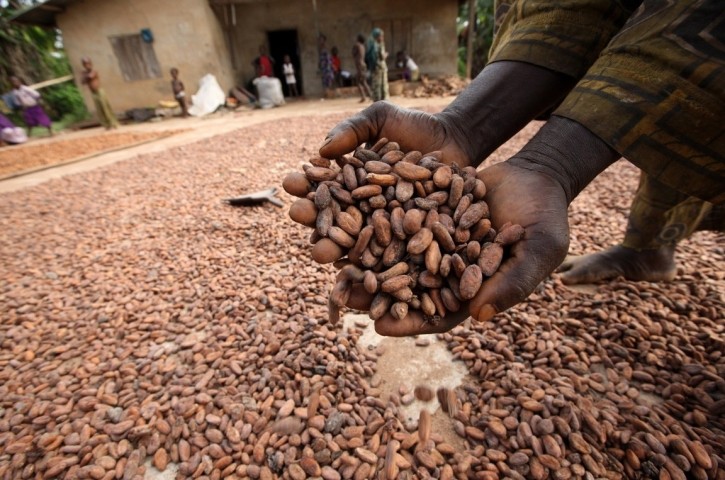
A consortium of European civil society organizations that includes Oxfam, Solidaridad and the VOICE Network today released the 2015 Cocoa Barometer, a report evaluating cocoa sustainability efforts.
It called on the chocolate and cocoa industry to establish a Global Cocoa Fund to fairly redistribute profits in the value chain to farmers and urged the chocolate industry to assess poverty levels within their supply chains.
According to the report, just 6.6% of the value of a $1 chocolate bar reaches the farmer, while chocolate manufacturers receive 35.2% and retail & taxes take 44.2%.
‘Missing core of the problem‘
Speaking to ConfectioneryNews, Antonie Fountain, managing director of the VOICE Network and co-author of the report, said: “The main message is that sustainability efforts are not addressing the core of the problem which is poverty.”
The Barometer said cocoa does not provide a living income for farmers and their families and blamed poverty for the most serious ills in the cocoa sector such as unlawful child labor, human trafficking, illiteracy and malnutrition.
Fountain said that while increasing farm sizes and productivity - the focus of most industry programs - could play a role, there was limited evidence to say it led to significantly higher net farm income. Manufacturers need to be part of a multi-stakeholder process to improve the farm gate price for cocoa farmer, he said.
Global Cocoa Fund
The Barometer proposed placing a tax or premium at the commodity exchange market that would be fed into a Global Cocoa Fund and redistributed to farmers. This would be financed mainly by consumers paying more for chocolate.
Fountain said: “The problem is that people aren’t paying a decent price for the end product….Most of the larger chocolate companies, their CEOs earn more than their annual sustainability commitments. Chocolate companies could reduce the pay of their CEO, but they cannot reduce the content of cocoa in their products.”
The Barometer called on chocolate industry sustainability programs to align and establish economic measures for poverty, then work towards bringing farmers out.
It added that the cocoa price must rise to ensure cocoa remains attractive to the next generation of farmers, particularly as the current generation reaches life expectancy.
Cocoa prices have been on the rise in recent years, but the Barometer said the price – adjusted for inflation – had only been lower three times in history: During the American civil war and the First Second World Wars.
Market consolidation: ‘That kite don’t fly’
Fountain said that the farm gate price for cocoa perhaps needed to double to reflect the true costs of cocoa cultivation. However, the VOICE Network chief said the chocolate industry had been reluctant to discuss the cocoa price, perhaps fearing anti-trust authorities and worrying upping consumer prices could harm profits.
He added that most firms claim they have no influence on pricing.
Six chocolate manufacturers control 40% of the global chocolate market. Barry Callebaut and Cargill will produce about 70-80% of the world’s couverture chocolate if the latter’s deal to buy ADM’s chocolate business is approved. “You can’t say you don’t have an influence on pricing,” said Fountain. “That kite don’t fly.”
“When key players dominate an industry, it’s not usually good for people at the bottom of the chain,” he said.
Marketing budget vs sustainable cocoa pledges
Retailers ‘staying away from the conversation’
“Many of the retailers are quite comfortable in staying away from the conversation,” said Antonie Fountain, yet they set consumer prices. He said the retailers were demanding sustainable cocoa, but were in many cases not prepared to pay for it. He said some retailers dictated prices to brands and would delist products or give them poor shelf positioning if manufacturers were not compliant.
But even if the major chocolate manufacturers distributed half of annual profits among the 5.5 million smallholder cocoa farmers worldwide it would still leave most farmers below the extreme poverty line.
However, the Barometer said: “If companies would decide to invest as much money in the cocoa producers as in marketing, most of cocoa’s problems could be solved overnight.”
The 2009 Cocoa Barometer calculated that that just 1% of the marketing budget of the biggest chocolate manufacturers ($86m per year) would cover costs to train half the cocoa farmer population in Côte d’Ivoire.
Unorganized farmers
The latest report urged companies to do more to target unorganized farmers – echoing the World Wide Fund for Nature (WWF’s) assessment that the bottom 25% of cocoa producers are responsible for 40-50% of negative impacts, such as deforestation and underpaid laborers.
Fountain said the industry should work together with governments to encourage farmers to join cooperatives, perhaps by offering incentives.
Good news, bad news: Company sustainability programs
What about certified cocoa?
Certified chocolate production has risen from 2% in 2009, to almost 16% of global chocolate sales in the 2015, according to the latest Cocoa Barometer.
The 2015 Cocoa Barometer continued that companies’ sustainability programs must be evaluated by a third party. It praised Nestlé for allowing the Fair Labor Association to freely scrutinize its cocoa supply chain and the Nestlé Cocoa Plan.
The report said: “Most companies report progress in their annual reports, but these are usually ‘success stories’, and true lessons learned and/or challenges the companies face are still mostly lacking.”
The report welcomed CocoaAction, a platform run by the World Cocoa Foundation that aims to align the cocoa sustainability programs of the top players in the chocolate industry. “At the same time, the amount of farmers that the plan is aiming to reach is just a fraction of all of the cocoa farmers in West Africa, many of whom are already being reached through current CocoaAction members in their own programmes,” said the report.
Cocoa Barometer 2015: Key Recommendations to industry
- Commit to 100% sustainable independently verified cocoa purchasing
- Redistribute internal costs towards more sustainable procurement
- Be transparent about payments to governments and national cocoa institutions
- Develop baseline business models for living income in all sustainability programmes
- Share collected data on cocoa
- Have in place a human rights due diligence process
